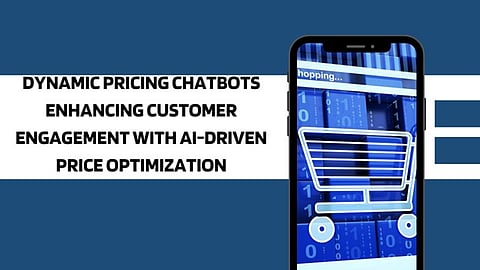

Amongst the various rapid advancements in the e-commerce field were chatbot embedding of dynamic pricing-and such fitting technology turns out to be radical in its transformation of the interface of customers with businesses, and broad transformation of price strategies. The idea, put forth by Karthik Ramakrishnan, involves AI, machine learning, and NLP to generate personalized and data-driven pricing experiences. These bots are again reforming digital retail to improve those merchants' conversion rates and ensure a four point remaining national value customer content quota. Of course, in light of the fact that we can expect an immense manifold growth of chatbots worldwide, these systems will see a growing involvement in the operations of businesses across the retailing, healthcare, BFSI, and travel sectors.
Dynamic pricing chatbots are one of the most significant advancements in e-commerce automation. Utilizing machine learning and real-time analytics, these AI-fueled systems offer personalized pricing based on customer behavior, market demand, and competitor strategies. The global chatbot market is estimated to have revenue in 2023 at $5.63 billion, expanding at a CAGR of 34.75%, due to numerous demands for intelligent automation spanning across different verticals. Business success is assured by implementing dynamic pricing chatbots, which provide improved KPIs; any business with up to 8% net margin gains in the first year and a revenue increase in excess of 2-7% is here.
Dynamic pricing chatbots are built on a sophisticated technical architecture that includes several key components. At the heart of these systems is the NLP engine, which allows chatbots to understand and respond to customer queries with remarkable accuracy. Modern NLP models now recognize intents with 85-90% accuracy and process requests in under three seconds for most interactions. This engine, powered by transformer models, can handle multiple languages and dialects, enhancing its applicability in global markets.
Alongside NLP, the pricing analytics engine forms the computational backbone, leveraging machine learning models to optimize pricing in real-time. These models analyze over 100 million pricing decisions annually, refining future recommendations based on customer segmentation and transaction history. The integration of these advanced models allows businesses to respond quickly to market fluctuations, boosting both revenue and customer satisfaction.
Dynamic pricing chatbots depend heavily on data integration from innumerable data points. Businesses normally analyze up to 300 different customer interactions to make pricing decisions, so they're considering everything from browsing across devices and platforms. All this data is then converted into valuable information in real-time for the company to make its competitive position and increase profit margins. This layer of data integration ensures that pricing models remain updated and dynamic according to changes in consumer behavior and market fluctuations for optimum price effectiveness.
On AI-generated systems for handling extremely large datasets, customer loyalty scores, seasonal demand trends, and real-time market data are analyzed as well. Attached with the feature of real-time market analysis, once these systems identify any price changes by competitors, they consider dynamic pricing to serve that business within minutes of detectability.
Implementing dynamic pricing chatbots needs a structured and phased approach for smooth integration and the realization of benefits. Studies show that organizations that even partially implement dynamic pricing in their product catalog are more successful with the approach. Initial implementations that covered 20-25% of the product catalog achieved optimal customer acceptance rates and revenue increases of 15-20%. By kicking the process, a business can adjust its price strategies and fine-tune its systems according to the feedback gathered from the initial results, thereby stimulating customer engagement leading to performance gains.
AI-driven risk management frameworks are also essential for detecting and mitigating pricing anomalies. By processing millions of data points daily, these systems identify potential pricing issues and improve decision-making speed, ensuring fair and transparent pricing, which is crucial for building long-term customer trust.
The future for dynamic pricing chatbots is bright because they are based on future technologies like voice commerce, blockchain, and predictive analytics. Voice commerce is on a very fast-growing trajectory and is expected to reach a $32 billion market by 2025. Pricing systems may convert point voice transactions and make them more efficient for customers to engage and buy products.
As these technologies evolve, so will the growth of businesses concerning speedier and more accurate decision-making processes and greater consistency of prices. AI, blockchain, and voice commerce will transform the next generation of digital retail strategies.
Today, dynamic pricing chatbots are reinventing the hold or relationship with customers through their price-optimal, AI-underpinned level. Through advanced AI and machine learning resulting in real-time analytics, they enable organizations to maintain customer satisfaction while offering personalized pricing. As Karthik Ramakrishnan states, the future of digital retail is all led by this technology with the integration of voice commerce and blockchain into their evolution. Dynamic pricing chatbots promise to become a fundamental part of modern e-commerce approach by optimizing ways of pricing and enhancing efficiency in the process.pricing chatbots are poised to become essential components of modern e-commerce strategies.
